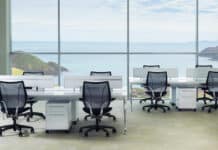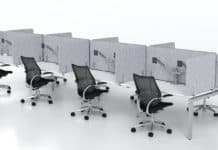By Jillian Ruffino
Published in the May 2007 issue of Today’s Facility Manager

The American employment landscape is being redefined, not only due to technological innovation, but also because everything is moving at a pace faster than ever before. In order for employers to remain relevant and retain good workers, facility managers must ensure the furniture they specify can accommodate this new world.
Workplace Changes
There are few Americans in the work force who expect to remain at the same company over the course of an entire career. The Bureau of Labor Statistics found the number of men who have held the same job for over 10 years has dropped significantly in the past two decades. In 1983, 51% of men aged 40 to 44 had completed more than 10 years of service in their current position. In 2004, this number dropped to 36%. Younger women are also less apt to stay with a single employer for long periods of time.
There are other reasons, of course, for this trend toward accelerated employee churn. With more pressure on organizations to cut costs, downsizing and company reorganizations have forced today’s workers to be vigilant when it comes to employment.
Organizations are also witnessing a change in the way offices are used. It is far more common today for companies to incorporate flexible working arrangements, since more people are conducting business in home offices.
Unconventional arrangements also increasing in regularity include independent contracting, on call work, and work for temporary help agencies and contract firms. The U.S. Department of Labor reports that, in the last decade, “the number of workers with alternative arrangements has increased by 21%, representing about 11% of the employed in 2005.”
Furthermore, workers are remaining in the labor pool longer than ever before. As John Hamilton, manager, industrial design for Grand Rapids, MI-based Steelcase Inc., explains, “For the first time, there are four generations sharing the workplace, including 20-somethings just starting out and baby boomers not quite ready to retire.”
Talent Wars
When an office is already furnished, or could be appointed cheaply, it might seem intuitive to equip the space for the appropriate number of people and walk away. This could be a mistake that costs an organization time (for employee training when dissatisfied workers leave), money (in revenue lost in the absence of talented, highly desired teams), and the overall quality of its public image and output.
For Kirt Martin, principal design manager for Caledonia, MI-based Turnstone, “Changes must be made when organizations fail to attract and retain the best and brightest of new employees. Talent wars will be bigger than ever in the future.”
Taking a look at the various groups that must be considered, Mark Dlugolecki, vice president of sales for Holland, MI-based Trendway, comments, “Employee retention continues to be a main focus and challenge. One example is the diverse dichotomy between the baby boomers, who are accustomed to a hard wall office environment, and new graduates who gravitate toward an open office teaming environment.”
Facility managers must furnish the needs of both groups while remaining mindful of the various forces affecting employment. With these trends in mind, how should a facility manager view furniture in commercial facilities?
Moving With Change
Flexibility is sorely needed in the modern workplace. Kris Yates, president, business markets for KI, headquartered in Green Bay, WI, explains, “Facility managers should be aware of how the physical workspace supports the overall objective of the organization. Are turnaround times becoming shorter while the need for multi-disciplined teams (to meet those deadlines) is decreasing? If so, collaboration is important, and the space must accommodate it on an impromptu basis.”
To be flexible means to be able to be adaptable and versatile, and these qualities are precisely what furniture of the past lacked. Today, furniture must fit every expectation.
One solution is to incorporate furniture that is portable and easily reconfigured. Another is to provide entire offices that can be rearranged. Architectural walls might provide this type of movability.
Yates claims, “Architectural walls can be put into place quickly and moved easily. They allow facility managers to change office layouts from open to closed, deal with employment growth, or support new styles of working.”
Hamilton notes, “Movable walls simply outperform traditional drywall construction. They are durable and arrive fully assembled and ready to install. They also offer easier, faster installation, are more environmentally sound, and include additional aesthetic options.”
Also, with faster turnaround rates and more shared workspaces, furniture needs to be ergonomically viable for a larger number of people; it can no longer be assumed the same worker will be sitting in the same chair each day.
Tom Revelle, vice president of marketing for New York, NY-based Humanscale, says, “The newest task chairs feature more automatic functionality and require fewer manual adjustments. These innovations are a dramatic improvement over older generation chairs that often required up to 10 manual adjustments.” This way, a greater number of people can use seating comfortably.
Don Mead, vice president of Muscatine, IA-based The HON Company, advises facility managers to take full stock of a company’s needs before purchasing any furniture. He suggests talking to department heads and the people who will regularly occupy office spaces. Facility managers should also understand how the organization currently operates and how it will change to accommodate future growth.
Integration is also an issue in a world of employee musical chairs. To be sure office furniture remains relevant, it should be possible to mix and match all components. This is based on advice from Dlugolecki, who notes, “The ability to incorporate multiple systems, panel hung components, and movable wall products could result in an overall cost saving for furniture procurement.”
Many organizations understand that savings can be realized when furniture adapts to smaller technology and social change. When workers can check their e-mail on the way to the office, it simply isn’t necessary to have large, anchored offices standing unused, unoccupied, and irrelevant.
The need for large furniture is also diminishing as technology becomes smaller. Revelle explains, “New office installations feature desks that are smaller than those of the last 30 years, primarily because flat panel monitor technology has allowed the monitor to fit in places other than the corner of an L-shaped workstation.”
Like Home
With many of the aforementioned trends expected to continue and grow, furniture in commercial facilities will keep evolving. Of the future, Martin asks, “Will the office of the future look like an office?”
It may be what is traditionally thought of as an “office” will change drastically as flexible schedules and communication devices blur the line between home and office. Yates predicts, “Furniture for commercial facilities will support a residential aesthetic as offices increasingly take on the look and feel of home. Furniture will incorporate less steel and more mixed materials, including wood and painted finishes.”
Facility managers who understand today’s trends can make educated purchases to save time, money, and hassle by boosting productivity with minimal expense. This is the new world of furniture in commercial facilities.
This article was based on interviews with Dlugolecki, Hamilton, Martin, Mead, Revelle, and Yates.




















![[VIDEO] Collect Asset Data at the Speed of Walking a Building](https://facilityexecutive.com/wp-content/uploads/2024/02/maxresdefault-324x160.jpg)